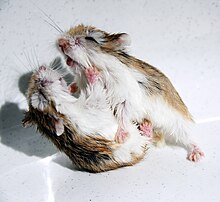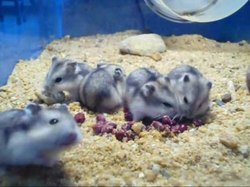Animal Kingdom
Description
Hamsters are typically stout-bodied, with tails shorter than body length, and have small, furry ears, short, stocky legs, and wide feet. They have thick, silky fur, which can be long or short, colored black, grey, honey, white, brown, yellow, red, or a mix, depending on the species. Two species of hamster belonging to the genus Phodopus, Campbell's dwarf hamster (P. campbelli) and the Djungarian hamster (P. sungorus), and two of the genus Cricetulus, the Chinese striped hamster (C. barabensis) and the Chinese hamster (C. griseus) have a dark stripe down their heads to their tails. The species of genus Phodopus are the smallest, with bodies 5.5 to 10.5 cm (2.2 to 4.1 in) long; the largest is the European hamster (Cricetus cricetus), measuring up to 34 cm (13.4 in) long, not including a short tail of up to 6 cm (2.4 in).
The hamster tail can be difficult to see, as it is usually not very long (about 1/6 the length of the body), with the exception of the Chinese hamster, which has a tail the same length as the body. One rodent characteristic that can be highly visible in hamsters is their sharp incisors; they have an upper pair and lower pair which grow continuously throughout life, so must be regularly worn down. Hamsters are very flexible, but their bones are somewhat fragile. They are extremely susceptible to rapid temperature changes and drafts, as well as extreme heat or cold.
Senses
Hamsters have poor eyesight; they are nearsighted and colorblind.[10][11] Hamsters have scent glands on their flanks (and abdomens in Chinese and dwarf hamsters) which they rub against the substrate, leaving a scent trail.[12] Hamsters also use their sense of smell to distinguish between the sexes, and to locate food. They are also particularly sensitive to high-pitched noises and can hear and communicate in the ultrasonic range.[5]
Diet
Hamsters are omnivores. Although pet hamsters can survive on a diet of exclusively commercial hamster food, other items, such as vegetables, fruits, seeds, and nuts, can be given. Hamsters in the Middle East have been known to hunt in packs to find insects for food.[13] Hamsters are hindgut fermenters and eat their own feces (coprophagy) to recover nutrients digested in the hindgut, but not absorbed.[2]
Behavior
Feeding
A behavioral characteristic of hamsters is food hoarding. They carry food in their spacious cheek pouches to their underground storage chambers. When full, the cheeks can make their heads double, or even triple in size.[2]. Hamsters lose weight during the autumn months in anticipation of winter. This occurs even when hamsters are kept as pets and is related to an increase in exercise.[14]
Social behavior
Most hamsters are strictly solitary. If housed together, acute and chronic stress may occur,[6] and they may fight fiercely, sometimes fatally. Dwarf hamster species may tolerate siblings or same-gender unrelated hamsters if introduced at an early enough age, but this cannot be guaranteed. hibernate.[16]
Burrowing behavior
All hamsters are excellent diggers, constructing burrows with one or more entrances, with galleries connected to chambers for nesting, food storage, and other activities.[2] They use their fore- and hindlegs, as well as their snouts and teeth, for digging. In the wild, the burrow buffers extreme ambient temperatures, offers relatively stable climatic conditions, and protects against predators. Syrian hamsters dig their burrows generally at a depth of 0.7 m.[17] A burrow includes a steep entrance pipe (4–5 cm in diameter), a nesting and a hoarding chamber and a blind-ending branch for urination. Laboratory hamsters have not lost their ability to dig burrows; in fact, they will do this with great vigor and skill if they are provided with the appropriate substrate.[6]
Wild hamsters will also appropriate tunnels made by other mammals; the Djungarian hamster, for instance, uses paths and burrows of the pika.[18]
Reproduction
Gestation and fecundity
Syrian hamsters are seasonal breeders and will produce several litters a year with several pups in each litter. The breeding season is from April to October in the Northern Hemisphere, with two to five litters of one to 13 young being born after a gestation period of 16 to 23 days.[13] Dwarf hamsters breed all through the year. Gestation lasts 16 to 18 days for Syrian hamsters, 18 to 21 days for Russian hamsters, 21 to 23 days for Chinese hamsters and 23 to 30 for Roborovski hamsters. The average litter size for Syrian hamsters is about seven pups, but can be as great as 24, which is the maximum number of pups that can be contained in the uterus. Campbell's dwarf hamsters tend to have four to eight pups in a litter, but can have up to 13. Winter white hamsters tend to have slightly smaller litters, as do Chinese and Roborovski hamsters.
.Longevity
Syrian hamsters typically live no more than two to three years in captivity, and less in the wild. Russian hamsters (Campbell's and Djungarian) live about two to four years in captivity, and Chinese hamsters 21⁄2–3 years. The smaller Roborovski hamster often lives to three years in captivity.[2]
Society and culture
Hamsters as pets
The best-known species of hamster is the golden or Syrian hamster (Mesocricetus auratus), which is the type most commonly kept as pets. There are numerous Syrian hamster variations including long-haired varieties and different colors. British zoologist Leonard Goodwin claimed most hamsters kept in the United Kingdom were descended from the colony he introduced for medical research purposes during the Second World War.[19]
Other hamsters commonly kept as pets are the three species of dwarf hamster. Campbell's dwarf hamster (Phodopus campbelli) is the most common—they are also sometimes called "Russian dwarfs"; however, many hamsters are from Russia, so this ambiguous name does not distinguish them from other species appropriately. The coat of the winter white dwarf hamster (Phodopus sungorus) turns almost white during winter (when the hours of daylight decrease).[3] The Roborovski hamster (Phodopus roborovskii) is extremely small and fast, making it difficult to keep as a pet.[2]
Hamster shows
A hamster show is an event in which people gather hamsters to judge them against each other.[20] Hamster shows are also places where people share their enthusiasm for hamsters among attendees. Hamster shows feature an exhibition of the hamsters participating in the judging.[20]
The judging of hamsters usually includes a goal of promoting hamsters which conform to natural or established varieties of hamsters.[20] By awarding hamsters which match standard hamster types, hamster shows encourage planned and careful hamster breeding.[20]






Komentar
Posting Komentar